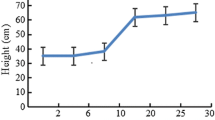Abstract
The economic yield of chickpea, lentil, wheat, cauliflower, barseem, and toria in a 12-m-wide strip to the south of 8 ± 1-year-old Eucalyptus tereticornis shelterbelts (three different locations) was reduced by more than half. Among all the crops under study, the yield of chickpea was reduced by the maximum extent. The content of soil phytotoxins was maximum in the litter-free top soil surface, compared to that at 30 or 60 cm depths, at all distances from the Eucalyptus. Maximum content of phytotoxins was found at 1 m from the tree line for all depths. These soil phytotoxins impaired the germination of Lens esculentum, thus indicating an allelopathic effect. It is included that the poor perfornce of crops in the sheltered area is related to an allelopathic effect of the Eucalyptus.
Similar content being viewed by others
References
Agrawal RL (1980) Seed Technology. Oxford and IBH Publishing Company, New Delhi
Al-Mousawi AH and Al-Naib FAG (1975) Allelopathic effects of Eucalyptus microtheca F Muell J Univ Kuwait Sci 2: 59–66
Al-Mousawi AH and Al-Naib FAG (1976) Volatile growth inhibitors produced by Eucalyptus microtheca. Bull Biol Res Cent 7: 17–23
Basu PK, Kapoor KS and Banerjee SK (1987) Allelopathic influence: an assessment on the response of agricultural crops growing near Eucalyptus tereticornis. Indian J Forestry 10(4): 267–271
Bhaskar V and Dasappa (1986) Ground flora in Eucalyptus plantation of different ages. In: Sharma JK, Nair CTS, Kedharnath S and Konda S, eds, Eucalyptus in India: Past, Present and Future, pp 213–224. KFRI Publ, Kerala, India
Caborn JM (1957) Shelterbelts and microclimate. For Comm Bull 29, pp 1–35. HM Stationery Office, Edinburgh
del Moral R and Muller GH (1970) The allelopathic effects of Eucalyptus camaldulensis. Am Midl Nat 83: 254–282
Duncan DB (1955) Multiple range and multiple F — test. Biometrics 11: 1–48
International Seed Testing Association (1976) International rules for seed testing. Seed Sci Technol 4: 180
Jaiswal PL (1980) Hand Book of Agriculture. Indian Council of Agricultural Research, New Delhi, 1303 pp
Jansen M (1954) Shelter effect: investigation into the aerodynamics of shelter and its effect on climate and crops. Danish Technical Press, Copenhagen
Kaminsky R and Muller WH (1977) The extraction of soil phytotoxins using a neutral EDTA solution. Soil Sci 124(4): 205–209
Kohli RK (1990) Allelopathic potential of Eucalyptus. Project Report, MAB-DOEN Project. India, 199 pp
Kohli RK (1987) Eucalyptus — an antisocial tree for social forestry. In: Khosla PK and Kohli RK, eds, Social Forestry for Rural Development, pp 235–241. Indian Society of Tree Scientists, Solan India
Kohli RK, Kaur K, Choudhary P, Kumari A and Saxena DB (1987) Negative aspects of Eucalyptus farming. In: Khurana DK and Khosla PK, eds, Agroforestry for Rural Needs, pp 225–233. Indian Society of Tree Scientists, Solan, India
Kohli RK, Singh D and Verma RC (1990) Influence of eucalypt shelterbelt on winter season agroecosystem. Agri Ecosystems Environ 33: 23–31
Marshal JK (1967) The effect of shelter on the productivity of grass land and field crops. Field Crops Abstr 20: 1–14
Poore MED and Fries C (1985) The ecological effects of Eucalyptus. FAO Forestry Paper 59, 87 pp
Rice EL (1984) Allelopathy. 2nd ed, Academic Press, New York, 422 pp
Seema (1989) Comparison of allelopathic potential of the root and shoot system of Eucalyptus. M Phil Thesis. Panjab University, Chandigarh, India
Singh D (1988) Role of volatile components of Eucalyptus tereticornis Sm leaves towards allelopathic properties of the tree. M Phil Thesis. Panjab University, Chandigarh, India
Singh D (1991) Phytotoxic properties of Eucalyptus with special reference to the role of its volatile components. PhD Thesis. Panjab University, Chandigarh, India
Story R (1967) Pasture patterns and associated soil water in partially cleaned woodland. Aus J Bot 15: 175–187
Suresh KK and Vinaya Rai RS (1988) Allelopathic exclusion of understorey by a few multi-purpose tree. I Trees Crops J 5: 143–151
Trease GE, Evans WC (1983) Text Book of Pharmacognosy, pp 200–213. Bailliere Tindall, London
van Eimern J (1964) Windbreaks and shelterbelts. Tech Note 549, WMD-No 147, TP 70, Geneva
Author information
Authors and Affiliations
Rights and permissions
About this article
Cite this article
Singh, D., Kohli, R.K. Impact of Eucalyptus tereticornis Sm. shelterbelts on crops. Agroforest Syst 20, 253–266 (1992). https://doi.org/10.1007/BF00053143
Issue Date:
DOI: https://doi.org/10.1007/BF00053143



